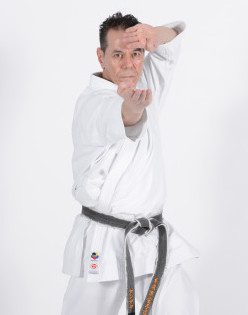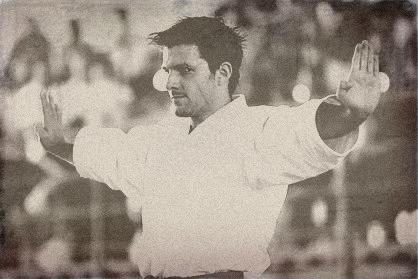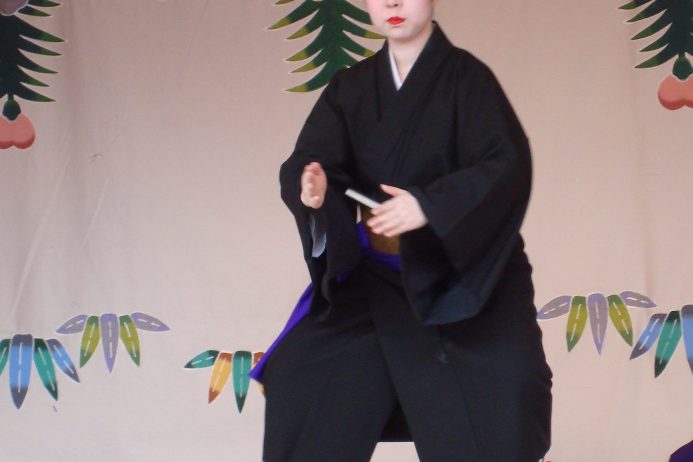Do you like kumite?
A quick internet search will give you thousands of ways to practice and improve your sparring skills.
But…
What about kata?
What about the millions of Karate people all over the world, looking for advice on how to improve their kata, only to end up finding – nothing?
Dude.
I used to be one of those desperate people!
Until I decided to take matters into my own hands…
Today I’ve compiled 51 of my personal favorite crazy ways to practice kata into one super killer article for you, applicable to all styles of Karate.
(To learn about self-defense applications of kata, read The Bunkai Blueprint.)
Because kata is much more than what meets the eye!
Now, check this out:
- Do the kata mirrored. Research shows that doing something on the ‘opposite’ side improves the ‘regular’ side too, by greasing neurological pathways in your brain associated with the kata’s movement pattern (known as the contralateral training effect). So, flip it over!
- Do the kata backwards. Start with the last movement and end with the first movement. This is similar to doing the kata mirrored, but a little bit harder.
- Do the kata mirrored and backwards. This is the ultimate brain twister. The goal is to do it with full power and speed, of course. Good luck!
- Do the kata with your eyes closed (or blindfolded). Shutting off a sense (in this case, your visual sense) will significantly increase the awareness and focus of your other senses (i.e balance, proprioception, hearing).
- Do the fast movements slow. Your body and mind was designed to take the path of least resistance. That’s how humans work. Unfortunately, this often means that you’ll have automated habits of ‘cheating’ through hard parts of kata by using the momentum gained from fast techniques. This could fix that.
- Do the slow movements fast. Even the slower movements should have a correct line of power transmission and sequential timing of body movements – which is exactly what doing them fast will teach you.
- Do the fast movements slow and the slow movements fast. This is the combination of the above two exercises. The balance and contrast between hard and soft (“go” and “ju” in Japanese) is the key takeaway here. Oh, and did I mention that 3-times kata world champion Luca Valdesi does this exercise almost every time I see him prepare for finals?
- Do the kata just using your upper body. Because when you immobilize your lower body, you truly appreciate where power originates.
- Do the kata with just your lower body. Anyone can do this exercise. But few can do it well; using kime, speed and power. Pay special attention to your posterior chain.
- Do the kata in your head (visualize). Our brains are surprisingly bad at discerning whether something happens in real life or “just” in our imagination. Use this to your advantage to practice your kata on the bus, at the grocery store, in the shower, at work, in bed or wherever. Research shows that first-person perspective works better than third-person perspective though.
- Visualize and time the kata. Then do the kata physically. It should take the exact same time. That’s when your mind and body are in complete harmony.
- Do the kata in your everyday clothes. Shoes too. Are your movements suddenly becoming impractical? Why? That’s just silly. Make them practical.
- Do the kata outside. The woods. The beach. The mountains. The desert. Choose a scenic spot and tap into the cosmic power of Mother Nature. (I totally sounded like a hippie there.)
- Do the kata as fast as you can. The whole thing. No cheating. Each technique completely done before the next one. Full speed. This requires a laser-like mental focus and discipline. Don’t worry about power or strength. It’s all about speed now.
- Do the kata as slowly as you can. This, on the other hand, is 100% mental torture. You can compete with a friend to make it more motivating. The slowest kata wins. Mental fatigue = you lose.
- Have friends surround you with focus pads and kick shields. As you perform the kata; strike, kick, punch and block with full force into the high impac gear, to make sure your techniques are battle ready.
- Do the bunkai. Because that’s why the kata was frickin’ m-a-d-e.
- Wear a weighted vest. This will add resistance to most of your movements, directional shifts and jumps. Try not to make your stance higher though (you will certainly want to).
- Wear ankle/wrist weights. This will add more resistance to your limbs, in all movements. But for your joint health, no fast movements!
- Practice smaller sequences of the kata. Narrow it down and just practice specific sequences in order to improve the whole.
- Practice single movements from the kata. Narrow it down even further and pinpoint specific techniques, to improve the whole.
- Do the kata 100 times in a row. Just for the hell of it.
- Roll a dice. Do the kata as many times as the dice shows. Choose another kata. Roll the dice again. Et cetera. Repeat for a set amount of time.
- Do the whole kata using just one stance. For example, neko-ashi dachi (cat stance), zenkutsu-dachi or kiba dachi. Same directions and techniques as usual, just changed stance.
- Do the whole kata with one arm tied behind your back. You never fully appreciate the importance of “hiki-te” (the withdrawing hand) until you take it away.
- Do the kata in water. But not above shoulder height. Water adds a unique kind of resistance, which provides a stimulating challenge for kata practice. Great for physical rehab too, as it eases the stress of your joints.
- Do the kata and pretend you’re “angry”. You’ll evetually dip into the limbic system (lizard brain) and actually become angry. That’s when things happen. You might cry. That’s okay. Nobody needs to see. It’s all about learning to ride your emotions, channeling them through the kata, eventually getting into the flow. With practice, you will be able to flip this switch instantly.
- Do the kata on ice. When sh*t goes down, balance is your body’s primary priority. And if you can balance on ice, you can balance on anything, bro.
- Do the kata while sitting on a friend’s shoulders. He/she performs the lower body movements (steps, stances and kicks), while you do the arm movements (punches, blocks, strikes, salutations etc.) Try to synch with each other. Then switch places. Both positions provide interesting challenges.
- Practice kihon. There’s a handful of common techniques found in every kata. By practicing these basic techniques (known as “kihon waza”), you will magically improve every single kata you know. Sounds like a no-brainer to me.
- Do the kata in front of an audience. There’s a common pressure associated with doing kata in front of an audience. That stress, or performance anxiety, is interpreted by your body like an actual situation of physical danger (cortisol levels rise, palms start to sweat, muscles tense up, adrenaline is released etc.).
- Film your kata. Because a mirror only reveals so much. And your sensei might be subject to repetition blindness. But remember to use various angles.
- Do your kata to music. Not because you dig Justin Bieber, but because the rhythm of certain music sparks a primal flame in our brains related to instinct. Try heavy bass drums. Try Japanese taiko. Whatever floats your boat and gets you going.
- Watch somebody else do kata. Either in real life or video. Preferably someone better than you. Research tells us that your brain’s mirror neurons will light up as if you were physically performing the kata yourself. The best part? You won’t have to wash your gi afterwards! (But sadly, you won’t really need that post-workout strawberry chocolate protein shake either…)
- Do the kata with a snorkel (or high altitude simulation mask). There’s a reason many Olympic champions go to Africa for training. They have a lot of mountains over there. And high altitudes makes it heavier to breathe. When it’s heavy to breathe, your body needs to push harder. Gradually your VO2 max, lung capacity and fatigue treshold (not to mention mental toughness) improves. That’s awesome. Famous MMA fighters do this.
- Lift heavy weights explosively, then do the kata. Explosive weight lifting (85% RM >) ignites your fast-twitch muscle fibers, which you should take advantage of by immediately practicing kata afterwards. In the world of sports science, this is known as “complex training”, and is generally done with plyometric exercises.
- Have people surround you. Tell them to attack you at random. You can only defend yourself using techniques from the kata. But keep it simple. Basic punches, kicks and blocks. Some grabs. Start slowly and gradually increase power and speed. Feel free to use protective gear.
- Do the kata with a partner who tests all your strikes/kicks by blocking them, and tests all your blocks by striking/kicking at them. This is a dynamic form of “kote kitae” (conditioning) and works surprisingly well with kids too.
- Do the kata at half speed. Snap each technique lightly. This is the #1 method for warming up, since it prepares your central nervous system for higher speed and power without risking injury. Keep strict technique, focus and kime however – just like at full speed.
- Do the kata with extra big movements. When things get serious, we tend to tense up and shrink our techniques’ range of motion (ROM). So practice with extra big movements in order to prevent that. We did this all the time with the female Japanese national team when I lived in Okinawa. Just remember to keep your elbows in, armpits closed and shoulders down.
- Do the kata without mirrors. Because sometimes we get caught up in staring at our own handsome faces a bit too much. (Or is that just me?)
- Do the kata with one leg fixed in the same spot. You can only move your other (free) leg around. You still need to perform all the correct stances, directions and techniques. Get it? Great for when the dojo is crowded.
- Spin around several times really fast, then do the kata while dizzy. Less painful than having somebody get you punch drunk, but gives you the same effect. Kids love this one too.
- Do the kata without a gi top. Have a friend check every movement for correct breathing, muscle and joint alignment. This is known as “shime”, and is what Goju-ryu stylists do with Sanchin kata and Shorin-ryu stylists do with Naihanchin kata. But the general concept applies to all kata, of course. Your friend can push you, pull you, pat you or even slap you.
- Do the kata while a friend counts (or claps). The crucial, and hard, thing is to never think about the next movement here. Be fully present in each technique. Just relax, and then “bam!”, explode each time you hear a count or clap. Can be done with various rhythm in counts/claps.
- Do the kata in extreme weather conditions. Heat, cold, rain, hail, sleet or snow. Not only will this test your spirit, but could effectively serve as a mental anchor for the rest of your life. This was the case with European and world team kata champion Lucio Maurino, when he was instructed by his mentor to perform kata Sochin under the moon in the snowy mountains of Italy, as revealed to me in one of our epic interviews.
- Do the kata uphill/downhill. This totally throws off your feeling and balance, since some movements will suddenly become harder and slower (uphill) while other will be easier and faster (downhill). The goal is to act as if the ground is level.
- Do the kata while a friend uses gestures or taunts to make you lose focus. Your friend can do anything (verbal or visual), but cannot touch you or hinder your movement. If you laugh/smile or lose focus in any way, you’ve failed.
- Do the kata while balancing a hardcover book on your head. The key lies in keeping a straight centerline. Try to gradually increase speed and power.
- Do the kata while standing on a balance board/swiss ball (or one leg). Similar to performing the kata on ice, except your lower body is now immobilized (you can’t change stances or move around), yet you are in constant struggle for balance.
- Lastly, just do the whole goddamn kata as if your life depended on it. No second thoughts. No looking back. No retreat. No surrender. Take no prisoners. If your gi isn’t totally messed up, and your belt isn’t on the ground next to a pool of vomit and a pool of sweat, then well, old sport, you probably just didn’t try hard enough. Try again. Refocus.
That’s it!
If you LIKE this article, send it to somebody who practices kata.
They’ll thank you.
(And hopefully they’ll read my FREE 7-Day Karate Nerd™ E-Mail Guide too.)
Lastly…
Feel free to add more exercises in the comment section.
Can we make it to 100? ; -)




93 Comments